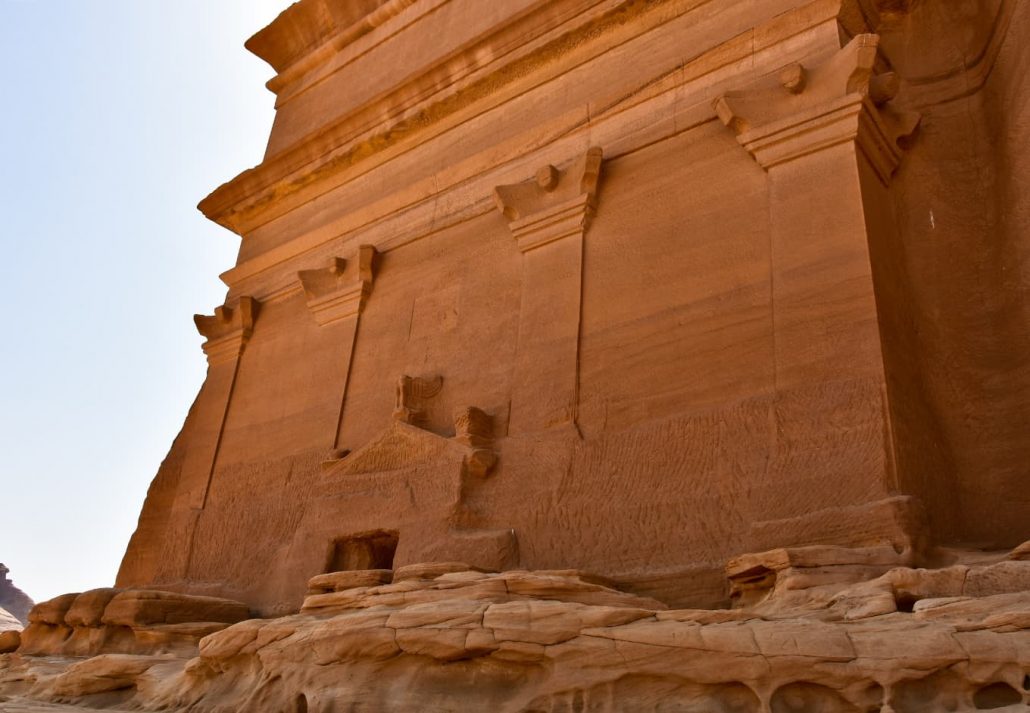Imagine a place steeped in ancient history, where towering tombs carved into sandstone cliffs whisper tales of a lost civilization. This is Al Hijr Archeological Site (also known as Hegra or Madain Saleh), a UNESCO World Heritage Site in Saudi Arabia and home to one of the most enigmatic structures – Qasr Al Farid.
For centuries, desert winds have carried whispers about this magnificent yet unfinished tomb. Carved by the Nabataeans, Qasr Al Farid stands apart from other monumental tombs in the area. Its imposing facade, isolated position, and unfinished state create an air of mystery that intrigues visitors today.
In this blog, we will unravel the secrets of Qasr Al Farid. We will delve into the history of the Nabataeans, explore the architectural marvel that is Qasr Al Farid, and uncover its unfinished state. Prepare to be transported back in time as we explore this fascinating relic of the ancient world.
Quick Jumplinks
- What is Qasr Al Farid?
- Nabataeans: The People Who Built Qasr Al Farid
- The Architecture of Qasr Al Farid
- Frequently Asked Questions
What is Qasr Al Farid?
The name “Qasr Al Farid” literally translates to “Lonely Castle” in English, a fitting title considering its isolation from the clusters of other tombs found in Madain Saleh. Unlike its neighbors in the region, Qasr Al Farid stands alone, carved majestically against the backdrop of golden sandstone cliffs.

This imposing structure is a testament to the architectural prowess of the Nabataeans. Towering 15 meters tall and 27 meters wide, its facade is a masterpiece of intricate carvings. Four pilasters dominate the front, topped by a single, ornate Nabataean crown – four being a unique feature compared to the typical two-column structures found in other tombs.

Qasr Al Farid holds another intriguing aspect – it’s unfinished. Roughly a third of the facade remains uncarved, as though abandoned in time. This unfinished state only adds to the mystique surrounding Qasr Al Farid. It ignites our imagination, leaving us to ponder stories that might have unfolded within its walls had it been completed.
Nabataeans: The People Who Built Qasr Al Farid
The magnificent Qasr Al Farid stands as a lasting testament to the ingenuity and architectural prowess of the Nabataeans. But who exactly were these people who carved their civilization out of the harsh desert landscape?

The enigmatic Nabataeans were originally a nomadic tribe that thrived in the northern Arabian peninsula between the 4th and 2nd century BCE. Masters of lucrative trade and water management, they began building great settlements and transformed the unforgiving desert environment into a flourishing hub on the incense route. Spanning from the southern Levant to northern Arabia, their location aided their trade and eventually, the Nabataeans grew immensely wealthy and powerful. One expression of this wealth can be traced back to the monuments they built.
Their most famous city, Petra, located in modern-day Jordan, is a breathtaking monument carved into rose-colored sandstone cliffs. The intricate temples and tombs of Petra showcase the engineering skills and artistic vision of the Nabataean Kingdom. Beyond agricultural activities, they developed political systems, fostered vibrant artistic expression, and displayed remarkable engineering skills in stonemasonry and astronomy. They even demonstrated astonishing hydraulic expertise, as evidenced by their construction of wells, cisterns, and intricate aqueducts.

Mada’in Saleh, once a major staging post and where Qasr Al Farid stands, is Petra’s sister city. Here, we can see similarities in architectural styles between Qasr Al Farid and the elaborate tombs found in Petra. Both demonstrate the Nabataeans’ talent for carving monumental structures that honored their dead and showcased their wealth and status.
However, the Nabataeans eventually came under Roman rule in the first century AD. While they retained some autonomy, their culture gradually assimilated into the Roman Empire. By the 4th century AD, the Nabataeans faded from historical records, leaving behind remarkable cities and architectural wonders like Qasr Al Farid as enduring legacies.
Recommended Read: The Ultimate Middle East Guide
The Architecture
Facade

The height of Qasr Al Farid is estimated to be four stories, reflecting the Nabataean custom of using tomb size to display wealth and social status. Unlike neighboring tombs with two facade pillars, Qasr Al Farid boasts four. Interestingly, the craftsmanship is more intricate at the top of the facade compared to the lower section. This has led archaeologists to believe the monument was carved from top to bottom. It’s possible these techniques were also used for other similar monuments in the area.
Interior

Unlike most monumental tombs in Madain Saleh, Qasr Al Farid stands completely isolated. In contrast, other grand tombs, like Qasr al-Bint, Qasr Al Sani tombs, and the Jabal al-Mahjar area, are grouped. This isolation sets Qasr Al Farid apart, making it one of the most famous tombs in the entire site. Since the tomb wasn’t completed, it’s impossible to say for sure what the interior would have looked like. We can only speculate based on other Nabataean tombs.
Qasr Al Farid stands as a powerful reminder of the enduring legacy of the Nabataeans. So, the next time you gaze upon images of Qasr Al Farid, remember the lost civilization it represents. Let it spark your curiosity to learn more about the Nabataeans and their fascinating world. After all, history is filled with enigmas waiting to be unraveled, and Qasr Al Farid is just one of the many treasures that continue to capture our imagination.
Frequently Asked Questions
Why is Qasr Al Farid called the Lonely Castle?
Unlike other tombs in Mada’in Saleh which are found in groups, Qasr Al Farid stands alone, carved majestically against the backdrop of golden-hued sandstone cliffs. This isolation is why it’s called the Lonely Castle.
How tall is it?
The height of Qasr Al Farid is estimated to be four stories high.
Why is the facade of Qasr Al Farid unfinished?
There are several theories about why Qasr Al Farid remains unfinished. Some archaeologists believe construction might have stopped due to the death of the intended occupant. Others suggest that financial constraints might have forced the project to a standstill.
What is the significance of Qasr Al Farid?
Qasr Al Farid is one of the most famous tombs in Mada’in Saleh. Its imposing facade, isolation, and unfinished state create an air of mystery that intrigues visitors today. It offers valuable insights and evidence into the architectural prowess and artistic expression of the Nabataeans.
CuddlyNest provides all accommodations to all travelers at the best price. Find unlimited travel inspiration on our blogs and social media channels Facebook, Instagram, and Pinterest.
Recommended Reads:
Elephant Rock: All You Need To Know
Rub Al Khali: The Empty Quarter Desert
Discover The Edge Of The World




